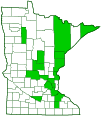sweet William catchfly
(Silene armeria)
Conservation • Description • Habitat • Ecology • Use • Distribution • Taxonomy
Conservation Status |
|
|||||||
| IUCN Red List | not listed |
|||||||
| NatureServe | NNA - Not applicable SNA - Not applicable |
|||||||
| Minnesota | not listed |
|||||||
Description |
||
Sweet William catchfly is a 4″ to 27″ but usually 8″ to 16″ tall, erect, annual forb that rises from a slender taproot. When young the plant forms a basal rosette of leaves. Later it sends up flowering stems. The stems are erect and unbranched below the inflorescence. They are hairless and are more or less covered with a whitish, waxy coating (glaucous). They sometimes have sticky areas below the upper nodes. Basal leaves are broad, lance-shaped to spatula-shaped, ¾″ to 2″ long, and hairless. They wither before the plants flower. Stem leaves are opposite, lance-shaped to elliptic, ⅜″ to 2⅓″ long, and from less than ¼″ to 1″ wide. They taper gradually to a pointed tip with straight sides along the tip. They are attached to the stem without a leaf stalk and are more or less clasping. They are hairless and more or less glaucous. The margins are untoothed. The inflorescence is a dense, head-like or branched cluster of flowers. Each cluster is subtended by a pair of ⅓″ long or less lance-shaped bracts. Flowers are about ½″ wide when fully open, and are on a short, upright stalk. The sepals are tinged purple and fused at the base into a tube (calyx) terminating in 5 short, erect lobes. The calyx tube is ½″ to ⅔″ long, and about ⅛″ wide, and constricted at the base with a navel-like indentation. It is club-shaped, gradually widening toward the apex. It has 10 major veins that are raised on the surface (prominent), forming ridges. The 5 petals are pink, unlobed, horizontally spreading, with a stalk-like narrow base (claw). There are 10 stamens that are slightly longer than the petals and 3, sometimes 4, styles, also longer than the petals. The fruit is a 3-chambered capsule with 6 or 8 spreading teeth at the top. |
||
Height |
||
4″ to 27″ but usually 8″ to 16″ |
||
Flower Color |
||
Pink or lavender |
||
Similar Species |
||
The long, narrow, purple-tinged calyx and dense clusters of pink flowers distinguishes this plant from other Silene species. |
||
Habitat |
||
Disturbed sites, especially near human habitation. Partial shade. |
||
Ecology |
||
Flowering |
||
June to July |
||
Pests and Diseases |
||
|
||
Use |
||
|
||
Distribution |
||||
|
Sources |
|||
| 6/27/2023 | ||||
Nativity |
||||
Native to Europe and Turkey. Introduced, widely cultivated, and naturalized in North America. |
||||
Occurrence |
||||
|
||||
Taxonomy |
|||
| Kingdom | Plantae (Plants) | ||
| Division | Tracheophyta (Vascular Plants) | ||
| Subdivision | Spermatophytina (Seed Plants) | ||
| Class | Magnoliopsida (Dicots) | ||
| Subclass | Caryophyllidae | ||
| Superorder | Caryophyllanae | ||
Order |
Caryophyllales (Pinks, Cactuses, and Allies) | ||
Family |
Caryophyllaceae (Pink) | ||
| Subfamily | Caryophylloideae | ||
| Tribe | Sileneae | ||
Genus |
Silene (catchflies) | ||
This species was formerly classified as Silene armeria. An analysis of the tribe Sileneae (Oxelman et al., 2001) determined that three new genera, Viscaria, Ixoca, and Atocion, formed a well supported group separate from Silene and Lychnis. Silene armeria became Atocion armeria, the type species of the new genus. The transfer has not been widely accepted. ITIS, GRIN, USDA PLANTS, NatureServe, Flora of North America, and World Flora Online continue to use the name Silene armeria. GBIF and Plants of the World Online use the name Atocion armeria. NCBI lists both names without indicating that one is a synonym of the other. |
|||
Subordinate Taxa |
|||
Several subordinate taxa (varieties and/or subspecies) have been described. However, these are thought to be environmentally induced modifications, and are not generally accepted. |
|||
Synonyms |
|||
Atocion armeria Atocion armerioides Lychnis armoraria Silene latifolia |
|||
Common Names |
|||
sweet William catchfly sweet-William catchfly sweet William silene thrift catchfly |
|||
Glossary
Bract
Modified leaf at the base of a flower stalk, flower cluster, or inflorescence.
Calyx
The flower cup. May be the group of outer floral leaves (sepals) collectively, or a tube with lobes.
Clasping
Describing a leaf that wholly or partly surrounds the stem but does not fuse at the base.
Claw
A stalk-like narrowed base of some petals and sepals.
Glaucous
Pale green or bluish gray due to a whitish, powdery or waxy film, as on a plum or a grape.
Visitor Photos |
|||||
Share your photo of this plant. |
|||||
| This button not working for you? Simply email us at info@MinnesotaSeasons.com. Attach one or more photos and, if you like, a caption. |
|||||
|
|||||
MinnesotaSeasons.com Photos |
|||||
|
|||||

Slideshows |
||

Visitor Videos |
|||
Share your video of this plant. |
|||
| This button not working for you? Simply email us at info@MinnesotaSeasons.com. Attach a video, a YouTube link, or a cloud storage link. |
|||
Other Videos |
|||
| Eastern Pale Clouded Yellow Nectaring モンキチョウ♀@ムシトリナデシコ訪花 sigma1920HD |
|||
About
Published on Aug 27, 2012 A white-form female of Eastern Pale Clouded Yellow (Colias erate poliographus, family Pieridae) visiting pink flowers of the Sweet William Catchfly (Silene armeria, family Caryophyllaceae) for nectar. Late-June 2012 in Japan. vid response 日本語による詳細はブログをご覧ください。 |
|||

Visitor Sightings |
|||||
Report a sighting of this plant. |
|||||
| This button not working for you? Simply email us at info@MinnesotaSeasons.com. Be sure to include a location. |
|||||
|
|||||
MinnesotaSeasons.com Sightings |
|||||

|
Created: Last Updated: © MinnesotaSeasons.com. All rights reserved. |
